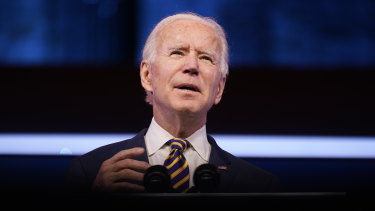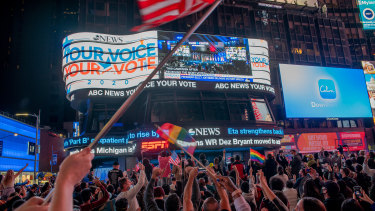Stimulus billions won’t carry Biden very far
With his presidential inauguration just weeks away, Joe Biden is confronting an economic crisis that is utterly unparalleled and yet eerily familiar.
Millions of Americans are out of work, small businesses are struggling to survive, hunger is rampant and people across the country fear getting kicked out of their homes. The moment was similarly perilous exactly 12 years ago, when Biden was the vice president-elect and preparing to take office.

“I remember the utter terror,” said Cecilia Rouse, who was an economic adviser in the Obama White House and has been chosen to lead Biden’s Council of Economic Advisers.
The $US900 billion ($1.2 trillion) pandemic relief plan that moderate lawmakers powered through Congress last month provides the incoming administration with some breathing room. This second tier of aid will deliver $US600 ($780) stimulus checks, assist small businesses and extend federal unemployment benefits through mid-March.
But as Biden has already made clear, it is simply a “down payment”— a brief bridge to get through a dark winter and not nearly enough to restore the economy’s health.
More than 19 million people are still receiving some type of unemployment benefit, and many business owners wonder whether they will be able to survive the year. The coronavirus crisis has worsened long-standing inequalities, with workers at the lower end of the income spectrum — who are disproportionately Black and Hispanic — bearing the brunt of the pain.
At the same time, bottlenecks in the COVID-19 vaccines’ rollout as well as fears about a much more transmissible strain of the virus could further delay the revival of large swathes of the economy like restaurants, travel, live entertainment and sports.
“We are in for some choppy waters, even as we continue to get to the other side of the pandemic,” Rouse said.
Yet despite the scorched earth left by the coronavirus, the economy is on a more stable footing in several ways than it was at the start of 2009.
Instead of hurtling down a hole with no clear view of the bottom, Biden is taking office when the economy is on an upward trajectory. However anaemic the growth, most analysts predict that 2021 will end better than it began even if there are stumbles along the way.
While this pandemic-related recession was larger in terms of initial job losses and closures, it is collateral damage from a health emergency and not a crack in the global financial system.
Now, Rouse said, “we know what to do.”
And in contrast to the Great Recession — which razed storehouses of wealth, in retirement accounts and homes, virtually overnight — many households have socked away money, lifting the savings rate to a 40-year high.
“Walking in this time, there is at least a cushion,” said Jason Furman, who led President Barack Obama’s Council of Economic Advisers and is now an economist at Harvard University’s John F. Kennedy School of Government.
But if the Biden administration will have a bit more running room on the economy, it is likely to have a lot less politically.
Senator Mitch McConnell of Kentucky, the Republicans’ leader in the Senate, was often intent on blocking Obama’s agenda, but his party was in the minority.
Biden must deal with a much more polarised Congress, which could still have McConnell as the Senate majority leader. Enacted after six months of stalemate, the $US900 billion ($1.2 trillion) pandemic package will help households and businesses get through the next few months.
But the Biden administration will have an uphill slog persuading lawmakers to approve more aid when this round ends. Biden will face resistance from some Republicans who put aside their concerns about debt when it came to cutting taxes in 2017 but who have rediscovered their inner deficit hawk.
McConnell has already pushed back against President Donald Trump’s — and Democrats’— repeated calls for increasing the stimulus checks to $2,000 from $600.
The failure to extend or expand federal aid when it expires this spring not only would cause significant hardships and needless suffering but also could seriously scar the economy, said Joseph Stiglitz, a Nobel Prize-winning economist.
Even though economic activity will most likely be on an upswing, the economy will remain weakened, Stiglitz said. Eviction moratoriums and mortgage forbearance have prevented families from losing their homes, but their housing debt has been accumulating even if it has not yet shown up on household balance sheets.
Many small businesses, particularly in the hard-hit service sector, which has been a source of low-wage jobs, will not survive. Economic inequality will increase.
“There’s been a lot of long-term damage,” Stiglitz said.
At the same time, the ranks of workers who have been unemployed for six months or longer have swelled to more than 4 million, increasing the chances that they may never find another job. Growing numbers of men and women are also dropping out of the labor force altogether.
None of those problems can really begin to be addressed without widely distributing the vaccines and reopening the schools so that parents, particularly mothers, can return to the workforce.
That is why economists say that funneling direct aid to state and local governments is so crucial.
“That sector has been gutted,” said Abigail Wozniak, a labor economist at the Federal Reserve Bank of Minneapolis, but it “is the sector that allows all the other sectors to operate.”
States and localities will play a critical role in the vaccine rollout and in providing emergency medical personnel. They will also be responsible for sending teachers back to classrooms that are safe and helping disadvantaged students regain lost ground.
Senate Republicans have been dead set against providing that kind of direct aid. McConnell has criticised it as a “blue-state bailout,” even though many red and blue states — and rural areas in particular — have lost revenues and public sector jobs.
Economists on the right and left agree that while there are echoes from the Great Recession, there are also important distinctions. Restoring the economy this time, they warn, will require a kind of economic serenity prayer: recognizing the similarities, identifying the contrasts, and having the wisdom to know the difference.

For Michael R. Strain, an economist at the conservative American Enterprise Institute, the economy has repaired itself more quickly than expected. He worries that some aid proposals, particularly those that prop up specific industries, would keep some dying businesses alive and “slow down the process of adjustment to a new post-virus economy.
“The faster that process happens, the faster the economy heals,” Strain said.
Many liberal economists, including those on the Biden team, though, warn against ignoring a crucial lesson from the last recession: Failing to move quickly to provide sufficient money to the people and businesses that need it can damage the economy far into the future.
Brian Deese, whom Biden has picked to lead the National Economic Council, where he worked as an assistant during the Obama administration, said making public investments was necessary to ensure economic growth.
“We’re in a moment where the risk of doing too little outweighs the risk of doing too much,” he said.
Business Briefing
Start the day with major stories, exclusive coverage and expert opinion from our leading business journalists delivered to your inbox. Sign up for the Herald‘s here and The Age‘s here.
Most Viewed in Business
Source: Thanks smh.com